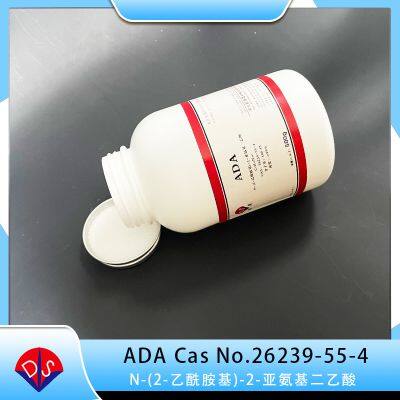Home > Products > Biological buffer > The pH range of N - (2-acetamido) -2-iminodiacetic acid (ADA) buffer
The pH range of N - (2-acetamido) -2-iminodiacetic acid (ADA) buffer
500 - 999 Kilograms
1000 - 4999 Kilograms
≥5000 Kilograms
- Shanghai
- T/T L/C PayPal Western Union
- 5 days
You May Like
-
HEPBS biological buffer is a powerful assistant in cell culture and cosmetics manufacturing
-
You can't help but know about the applications of CHAPS buffer
-
Introduction and Application of Biological Buffer BIS Tris Propane 64431-96-5
-
Biological buffer piperazine-1,4-diethylsulfonic acid monosodium salt PIPES-NA basic information
-
Exploration of Buffer Performance and Stability of PIPES-K2 108321-27-3
-
2- (N-morpholine) ethanesulfonic acid monohydrate MES monohydrate
Product Details
| CAS No. | 26239-55-4 | Source | Concrete | |
| Application | Scientific Research | Usage | Laboratory Reagents, Analytical Reagents, Diagnostic Reagents | |
| Specific Usage | For Biological Purpose | Content | Other, 99 | |
| Habit Appellation | Fine Chemicals | Property | Biochemical Reagent | |
| Classification | High Purity Material | Grade | AR | |
| Transport Package | carton | Specification | 500g/bottle | |
| Trademark | DS | Origin | China |
Product Description
N - (2-acetylamino) -2-iminodiacetic acid (ADA) is a multifunctional buffering agent that not only has superior buffering performance, allowing the solution to maintain a stable pH environment, but also has unparalleled advantages over other buffering agents, playing a role in rare fields. Let's take a look together below.
PH range of ADA buffer
The uniqueness of ADA buffer lies in its excellent buffering performance within the pH range of 6.0-7.2. Within this range, he is able to effectively maintain the acid-base balance of the solution, making the experimental conditions more stable.
Multi domain applications
1. Protein crystallization and microtubule polymerization: ADA is widely used in protein crystallization and microtubule polymerization experiments. The appropriate pH range enables ADA buffer to provide a stable acid-base environment in these experiments, helping to maintain the stability of proteins or microtubules.
2. Capillary electrophoresis: As a buffer for capillary electrophoresis, it can provide good separation performance. Especially in the separation of amiodarone and diethylamiodarone, ADA exhibits excellent performance, which helps to improve the accuracy of the experiment.
3. Differential scanning calorimetry: ADA was used as the sample buffer in the differential scanning calorimetry experiment. Its unique properties allow researchers to delve into the properties of samples such as fibroblast growth factor in situations where phosphate or sulfate buffer solutions cannot be studied.
Precautions and advantages
1. PH measurement accuracy: When using ADA buffer, ensure that an accurate pH meter is used for measurement to ensure the reliability of experimental results.
2. Multifunctionality: The versatility of ADA buffer makes it an important role in many biochemical experiments, able to adapt to different experimental requirements.
3. Combining strong metal ions: In terms of chemical properties, ADA is relatively active and has a strong ability to bind metal ions. It can complex with copper, nickel, zinc, calcium, magnesium, manganese, cobalt, etc. It should be noted that ADA buffering agents are generally not recommended in reaction solutions that require metal cations. Other suitable buffering agents should be selected based on experiments.
The N - (2-acetamido) -2-iminodiacetic acid (ADA) buffer has attracted widespread attention for its unique pH range and versatile applications. Its role in protein crystallization, microtubule polymerization, capillary electrophoresis, differential scanning calorimetry and other experiments provides researchers with important experimental tools and superior buffering performance.
As a manufacturer of ADA buffering agents, Desheng can provide raw materials with a purity of over 99%. It is easy to prepare, convenient to store, not prone to deterioration, and reduces performance. At present, we have cooperation with 80% of enterprises or laboratories in the market, and export to up to 100 countries. If you have any relevant intentions, feel free to contact us and give it a try!
Contact Us

- Hubei New Desheng Material Technology Co., Ltd
- Contact nameDoris Yang Chat Now
Product Categories
| Additive for blood collection | Biological buffer | Chemiluminescence reagent | Chromogenic substrate |
| enzyme preparation |
New Products
-
Characteristics and Use of TES Chemical Reagent as a Biological Buffer
-
The importance of BIS-TRIS HCl in electrophoresis, extraction, separation, and purification processes
-
3- (N-morpholine) propanesulfonic acid half sodium salt MOPS half sodium salt
-
What are the advantages of Desheng in producing 3- (N-morpholino) propanesulfonate sodium salt (MOPS-NA)?
-
Introduction to MOPSO Sodium 79803-73-9 Biological Buffer
-
Advantages of TOOS 82692-93-1 over other chromogenic substrates
-
Advantages and Preservation Details of TOPS Reagent 40567-80-4 for Chromogenic Substrate
-
Possible interfering factors of color change in ADOS 82692-96-4 substrate
-
Introduction to chromogenic substrate ADPS 82611-88-9
-
Application of ALPS 82611-85-6 chromogenic substrate in nucleic acid detection
-
Preparation and Use of New Trinder's Reagent DAOS 83777-30-4 Solution
-
The multifaceted applications of HDAOS 82692-88-4 as a chromogenic substrate
-
Application of MADB 209518-16-1 in Serum Muscle Enzyme Detection Kit
-
Application of MAOS 82692-97-5 in In Vitro Diagnostic Kit
-
The role of chromogenic substrate TODB 127544-88-1 in triglyceride detection
-
Advantages and characteristics of the chromogenic substrate DA64 (115871-19-7)
-
Performance characteristics and usage instructions of color developing substrate DA67 115871-18-6
-
Analysis of Luminol 521-31-3 Chemiluminescence Characteristics
-
Introduction and Precautions of Luminol Monosodium Salt 20666-12-0
-
Isoluminol reagent for chemiluminescence
-
Luminescence analysis of high-purity acridine ester NSP-DMAE-NHS194357-64-7
-
Direct chemiluminescence of acridine ester DMAE-NHS 115853-74-2
-
Detailed introduction of luminescent reagent NSP-SA 211106-69-3
-
Stability and precautions of acridine ester (NSP-SA-NHS)
Popular Searches
- sodium hypochlorite
- naclo
- Hypochlorite
- calcium hypochlorite
- calcium salt
- potassium butyl xanthate
- Calcium Sodium
- sodium hypochlorite production
- sodium process
- Granule Sodium
- hikers
- sodium hypochlorite water
- Sodium 80% Powder
- lime plastering
- sodium hypochlorite disinfection
- hypochlorite sodium
- Sodium Granular Powder
- hypochlorite production
- electrolysis sodium hypochlorite
- Swimming Pool Salt
- sea fish aquarium
- Of Calcium Powder
- quotation sample
- aquarium coral
- emamectin benzoate wdg
- Calcium Price Powder
- ptf
- aqua clear
- aquarium corals
- aquarium fish corals
Recommended Products
- Sodium Metasilicate Granular in detergent industrial
- STPP Sodium Metasilicate Granular in detergent industrial SMS-5H2O
- Cocamido Propyl Betaine 35% stability Factory Price
- Potato Dextrose Agar
- MacC /MacConkey Agar
- EMB Agar
- Tryptose
- Lecithin from egg yolk CAS:93685-90-6
- HSPC CAS:92128-87-5
- Casein acid CAS:65072-00-6
- Yeast extract powder
- Wheat gern powder CAS:68917-73-7
Find Similar Products By Category
- Chemicals > Chemical Reagent
Product Tags:
- Please Enter your Email Address
- Please enter the content for your inquiry.
We will find the most reliable suppliers for you according to your description.
Send Now-
 Doris Yang
Hi there! Welcome to my shop. Let me know if you have any questions.
Doris Yang
Hi there! Welcome to my shop. Let me know if you have any questions.
Your message has exceeded the limit.

- Contact supplier for lowest price
- Customized Request
- Request Sample
- Request Free Catalogs
Your message has exceeded the limit.
-
Purchase Quantity
-
*Sourcing Details
Your inquiry content must be between 10 to 5000 characters.
-
*Email
Please enter Your valid email address.
-
Mobile






